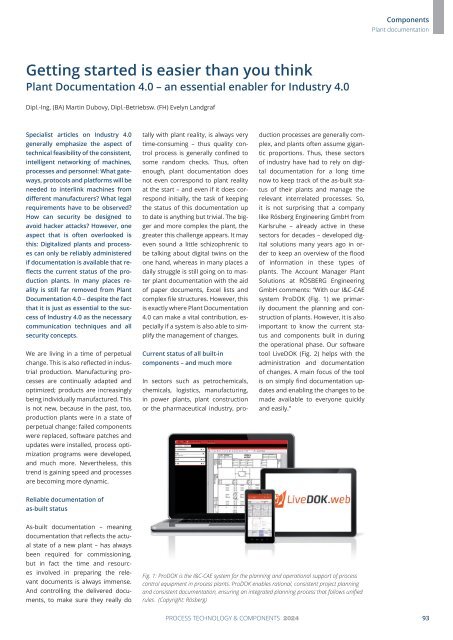PuK - Process Technology & Components 2024
A technical trade magazine with a history of more than 60 years.
A technical trade magazine with a history of more than 60 years.
You also want an ePaper? Increase the reach of your titles
YUMPU automatically turns print PDFs into web optimized ePapers that Google loves.
<strong>Components</strong><br />
Plant documentation<br />
Getting started is easier than you think<br />
Plant Documentation 4.0 – an essential enabler for Industry 4.0<br />
Dipl.-Ing. (BA) Martin Dubovy, Dipl.-Betriebsw. (FH) Evelyn Landgraf<br />
Specialist articles on Industry 4.0<br />
generally emphasize the aspect of<br />
technical feasibility of the consistent,<br />
intelligent networking of machines,<br />
processes and personnel: What gateways,<br />
protocols and platforms will be<br />
needed to interlink machines from<br />
different manufacturers? What legal<br />
requirements have to be observed?<br />
How can security be designed to<br />
avoid hacker attacks? However, one<br />
aspect that is often overlooked is<br />
this: Digitalized plants and processes<br />
can only be reliably administered<br />
if documentation is available that reflects<br />
the current status of the production<br />
plants. In many places reality<br />
is still far removed from Plant<br />
Documentation 4.0 – despite the fact<br />
that it is just as essential to the success<br />
of Industry 4.0 as the necessary<br />
communication techniques and all<br />
security concepts.<br />
We are living in a time of perpetual<br />
change. This is also reflected in industrial<br />
production. Manufacturing processes<br />
are continually adapted and<br />
optimized; products are increasingly<br />
being individually manufactured. This<br />
is not new, because in the past, too,<br />
production plants were in a state of<br />
perpetual change: failed components<br />
were replaced, software patches and<br />
updates were installed, process optimization<br />
programs were developed,<br />
and much more. Nevertheless, this<br />
trend is gaining speed and processes<br />
are becoming more dynamic.<br />
tally with plant reality, is always very<br />
time-consuming – thus quality control<br />
process is generally confined to<br />
some random checks. Thus, often<br />
enough, plant documentation does<br />
not even correspond to plant reality<br />
at the start – and even if it does correspond<br />
initially, the task of keeping<br />
the status of this documentation up<br />
to date is anything but trivial. The bigger<br />
and more complex the plant, the<br />
greater this challenge appears. It may<br />
even sound a little schizophrenic to<br />
be talking about digital twins on the<br />
one hand, whereas in many places a<br />
daily struggle is still going on to master<br />
plant documentation with the aid<br />
of paper documents, Excel lists and<br />
complex file structures. However, this<br />
is exactly where Plant Documentation<br />
4.0 can make a vital contribution, especially<br />
if a system is also able to simplify<br />
the management of changes.<br />
Current status of all built-in<br />
components – and much more<br />
In sectors such as petrochemicals,<br />
chemicals, logistics, manufacturing,<br />
in power plants, plant construction<br />
or the pharmaceutical industry, production<br />
processes are generally complex,<br />
and plants often assume gigantic<br />
proportions. Thus, these sectors<br />
of industry have had to rely on digital<br />
documentation for a long time<br />
now to keep track of the as-built status<br />
of their plants and manage the<br />
relevant interrelated processes. So,<br />
it is not surprising that a company<br />
like Rösberg Engineering GmbH from<br />
Karlsruhe – already active in these<br />
sectors for decades – developed digital<br />
solutions many years ago in order<br />
to keep an overview of the flood<br />
of information in these types of<br />
plants. The Account Manager Plant<br />
Solutions at RÖSBERG Engineering<br />
GmbH comments: “With our I&C-CAE<br />
system ProDOK (Fig. 1) we primarily<br />
document the planning and construction<br />
of plants. However, it is also<br />
important to know the current status<br />
and components built in during<br />
the operational phase. Our software<br />
tool LiveDOK (Fig. 2) helps with the<br />
administration and documentation<br />
of changes. A main focus of the tool<br />
is on simply find documentation updates<br />
and enabling the changes to be<br />
made available to everyone quickly<br />
and easily.”<br />
Reliable documentation of<br />
as-built status<br />
As-built documentation – meaning<br />
documentation that reflects the actual<br />
state of a new plant – has always<br />
been required for commissioning,<br />
but in fact the time and resources<br />
involved in preparing the relevant<br />
documents is always immense.<br />
And controlling the delivered documents,<br />
to make sure they really do<br />
Fig. 1: ProDOK is the I&C-CAE system for the planning and operational support of process<br />
control equipment in process plants. ProDOK enables rational, consistent project planning<br />
and consistent documentation, ensuring an integrated planning process that follows unified<br />
rules. (Copyright: Rösberg)<br />
PROCESS TECHNOLOGY & COMPONENTS <strong>2024</strong><br />
93

















